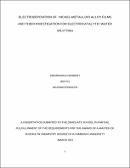| dc.contributor.author | Ssemwanga, Herbert | |
| dc.date.accessioned | 2022-02-11T08:07:19Z | |
| dc.date.available | 2022-02-11T08:07:19Z | |
| dc.date.issued | 2021-03 | |
| dc.identifier.citation | Ssemwanga, Herbert (2021) Electrodeposition of nickel-metalloid alloy films and their investigation for electrocatalytic water splitting. | en_US |
| dc.identifier.uri | https://kyuspace.kyu.ac.ug/xmlui/handle/20.500.12504/486 | |
| dc.description | xiii,69 p.: ill (somecol) | en_US |
| dc.description.abstract | Electrocatalytic splitting of the water molecule to produce hydrogen as an energy carrier provides a very promising pathway for provision of green and inexhaustible renewable energy for the future. The bottleneck of this reaction is the sluggish kinetics of the OER that makes the processes to be extremely energy intensive. Electrochemists have devoted much research efforts in finding cost-effective electrocatalysts that can speed up the OER during electrochemical water splitting. In this study, reference (NiB, NiP and NiTe) metalloid alloy powders pre-synthesized at Ruhr University, Germany and (Ni-Ga and Ni-In) metalloid films synthesized by electrodeposition were investigated for the OER activity in an alkaline electrolyte using LSV. The results showed that the optimal number of CV deposition cycles for the highest OER activity were 7 for Ni, 7 for Ga,3 for In,7 for Ni-In and 5 for Ni-Ga composite electrocatalytic films. The OER activity of 𝑁𝑖(𝑂𝐻)2formed by electrodeposition was several fold higher than that of the pure Ga and In films, as well as of the composite Ni-Ga and Ni-In films. It was concluded that CV deposition cycles that had the highest activity and therefore the highest performance were; 7 for Ni, 7 for Ga ,3 for In ,7 for Ni-In and 5 for Ni-Ga composite electrocatalytic films respectively. Ga and In species exist as discrete domains rather than alloys in the Ni-Ga and Ni-In composite films. The attempted method for synthesis of Ni-Ga and Ni-In alloy films by electrodeposition most likely led to the formation of Ni-Ga and Ni-In composite films with discrete domains of oxides of their respective elements but not alloys. | en_US |
| dc.language.iso | en | en_US |
| dc.publisher | Kyambogo University | en_US |
| dc.subject | Electrodeposition. | en_US |
| dc.subject | Electrocatalytic water splitting. | en_US |
| dc.subject | Investigation. | en_US |
| dc.title | Electrodeposition of nickel-metalloid alloy films and their investigation for electrocatalytic water splitting | en_US |
| dc.type | Thesis | en_US |

